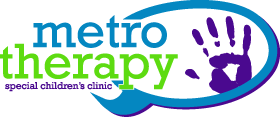How to Start Your Child’s Language Skills the Right Way
Welcome! In this article we will be talking about speech and language milestones, ways parents and caretakers can support their child meeting these milestones, and how Metro Therapy's speech-language pathologists can offer a helping hand.
Language Milestones: Birth-12 Months
From birth to three months, your child should be cooing, and making their first sounds, including “ooh,” “ah,” and “mmm”. From four to six months, they should be vocalizing different vowel sounds, sometimes combined with a consonant, such as “um,” “goo,” “dah.” From seven to nine months, they will be babbling long strings of sounds, such as “ma-ma-ma,” “up up,” or “ba-ba-ba” and they should be recognizing the names of some people and objects. Finally, from 10 to 12 months, they should be reaching for objects, pointing, waving, showing or giving objects. At this milestone, they should be responding to simple words and phrases like "go," "bye-bye," and "look at mommy." You may hear them start to say simple words like "mama," "dada," "hi," and "bye."
Language Milestones: 13-18 Months
From 13 to 18 months, your child should actively look around when asked "where" questions, for example "where's your blankey?" They should also follow directions to phrases such as "give me the ball," or "come here." You should notice them responding to simple commands by shaking their head for no and nodding for yes. Finally, they should begin to understand and use words for common objects, actions, and people in their lives.
Language Milestones: 19-24 Months
From 19 to 24 months, your child should use and understand at least 50 different words, however they might not always be intelligible words when they speak them. They should also start combining words together, for example “more water” or “go outside.” They should be following two-step directions, like "get the spoon and put it on the table." At this time, they will start using possessives, such as “daddy's sock.”.
Language Milestones: Two-Four Years
From two to three years, your child should start using plural words such as birds, or toys, using “ing” verbs, adding “-ed” to the end of words to make them past tense, asking "why" and "how" questions, and correcting producing most vowels. Then, from three to four years, your child should understand and use more locational words such as “inside,” “on,” “under.”
Language Milestones: Four-Five Years
Finally, from four to five years, your child should be producing grammatically correct sentences that are long and complex, using irregular plurals such as “feet,” “men,” understanding and using more location words such as “behind,” “beside,” and “between,” and producing most consonants correctly. Their speech should be relatively understandable in conversation at this age.
What Sounds Your Child Should Make at Different Ages?
2-3 Years: P, B, D, M, N, H, W, and all vowels.
3-4 Years: G, K, F, T, the ing-sound, and "yuh"
4-5 Years: V, J, S, ch, L, sh, and Z.
5-6 Years: R, voiced T-H, and J-J. The voiced T-H typically falls between two vowels. Examples of words with a voiceless T-H include “bother,” “weather,” or “father.” The J-J sound is an interesting one! The J-J sound is similar to the “ch” sound, but produced with your voice, instead of air through the mouth.
6+: Voiceless T-H. The “unvoiced” or “voiceless” T-H is typically at the end of the word or before a consonant. Examples of words with a voiceless T-H include “mouth,” “bath,” “throw,” or “truthful.”
How Parents and Caregivers Can Support Meeting Milestones
A few ways parents and caregivers can support their child to meet those milestones include:
Self-talk: Talk about what you are doing! Narrate your day while your child is around you.
Parallel talk: Similar to self-talk, but instead you narrate what your child is doing. For example, if they are playing with blocks, you may narrate, "the block goes up, up, up."
Repetitive books and songs: “Brown Bear, Brown Bear, What Do You See?” is a great example of a repetitive phrase that your child may catch on to. “Old McDonald” is a repetitive song that your child may catch on to and fill in the blanks.
Routine phrases: Aim to use phrases repetitively to encourage your child to repeat after you. These may include, "ready, set, go," or "one, two, three." Pausing near the end of the phrase allows your child the opportunity to fill in the last word.
Communication temptations: Withhold something you want to encourage them to express verbally what they want or what they need. This may include setting up things to encourage them to ask for your help. For example, placing one of their toys in a clear Tupperware; once they have noticed the toy, waiting a few moments next to the Tupperware to encourage them to ask for your help to retrieve the toy.
“Plus one” routine: When children begin to say words, repeat the word they said back to them and add an additional descriptor. For example, if they say "ball," repeat back "red ball."
Three-to-one ratio: We don't encourage parents to ask many questions in a row because it limits the child's ability to express what they want to say. Instead, we encourage parents to ask one question for every three comments.
Binary choices: Instead of yes or no questions, we encourage binary choices, such as "do you want water or milk?" This encourages children to choose and express which they want.
Because children imitate everything that parents or caretakers do, be sure to model good language skills for your child. That means using your clear speech and avoiding "baby talk." Additionally, if you have two children, we advise parents not to allow the older child to speak for the younger child. It's best to allow the younger child to express what they need!
If your child seems to be behind on any of these milestones, let's schedule a screening at Metro Therapy. Give us a call at 763-950-4500.
